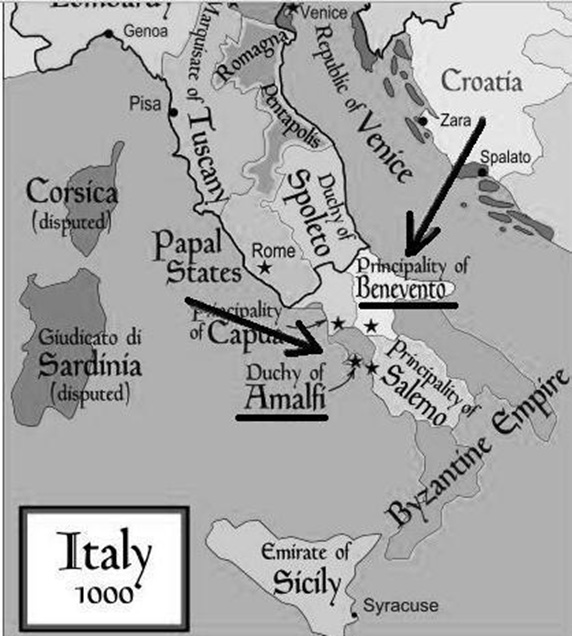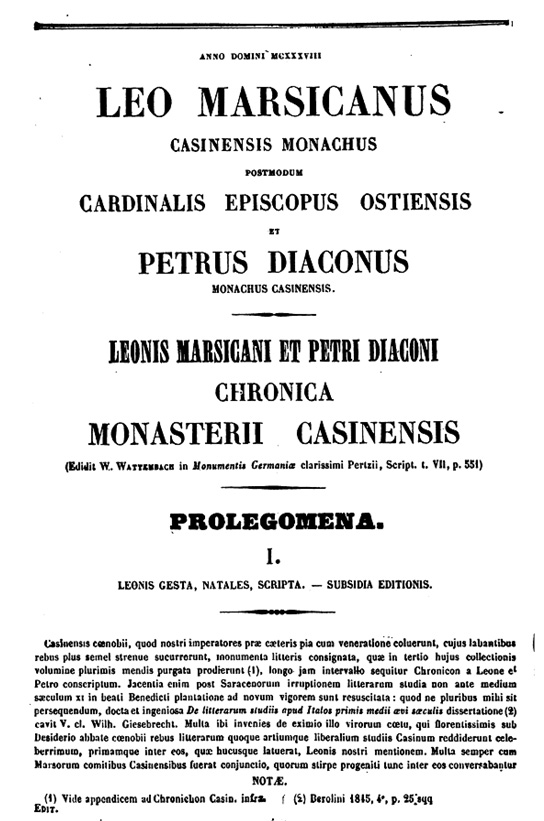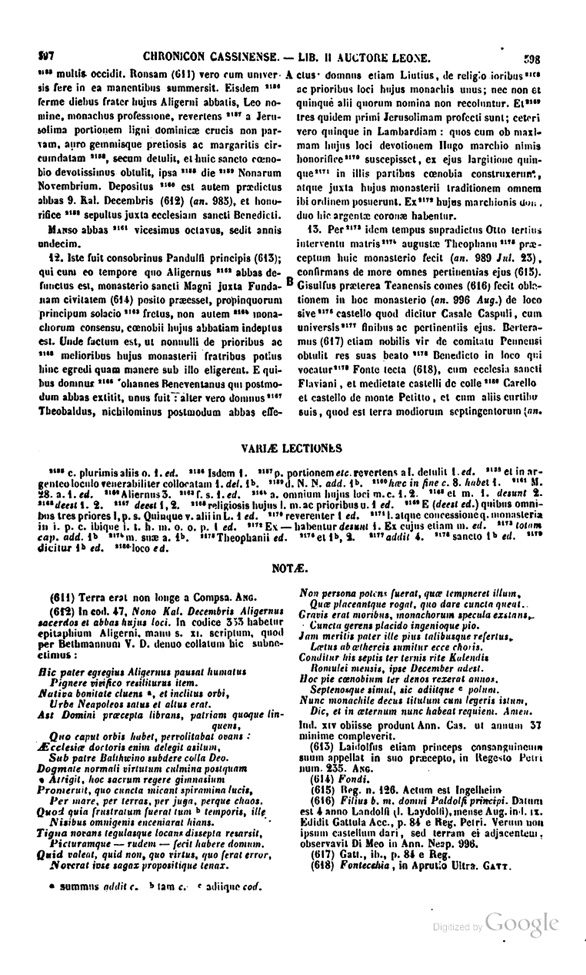Religious Affiliation of the Benedictine monks of Mount Athos
Great Georgian clergymen played an important role in the establishing of Roman Benedictine monks on the Mount Athos. George of Athos in his book "The Vitae of Our Blessed Fathers John and Euthymius and an Account of their Worthy Achievements" tells the story, of how Georgians let Leo the Great, the roman monk and his disciples in their monastery and then helped them to build their own cloister (Abuladze 1967:66).
In the scientific society there is a dispute about the religious affiliation of the Benedictine Monks. Some scientists believe that they were Orthodox Christians, while others argue and state that they were Catholics.
For example, Korneli Kekelidze believed that Georgia in X-XI centuries did not share the Greek rigorous views about Roman Church (Kekelidze 1957: 139). According to the Academic Elene Metreveli, Georgians showed sympathy towards Latin Monks and Catholic Religion (Metreveli 1998: 98). Such opinions are quite common in our scientific community.
The above-mentioned considerations by Korneli Kekelidze and Elene Metreveli are based on the information that can be found in the hagiographic works of George of Athos and Giorgi Mcire about the western Christians. First of all, they are referring to "The Vitae of Our Blessed Fathers John and Euthymius and an Account of their Worthy Achievements", which describes the friendship between Georgian and Benedictine Monks.
Mikhail Sabinin had a different idea about the Benedictine Monks dwelling on the Mount of Athos. He shared the Russian view that Benedictine Monks were Roman Christians: "It is obvious that in the 13th century on the Holy Mount there was a Roman Monastery, where the monks of Benedict order were of Orthodox Confession." [Sabinini 1882: 415][1].
Thus, according to Mikhail Sabinin Benedictine Monks of Mount Athos were Roman Orthodox, but in Elene Metreveli's view - Catholics (that is why it is believed that Georgian people had the sympathy towards Catholicism).
So, who were the Benedictine Monks of Mount Athos - Catholics and Orthodox?
The deep exploration of this issue is rather important, because it will enlighten the activities of Iverta Monasteri of Mount Athos, the most important Georgian spiritual and cultural centre.
What do we know about the Benedictine Monks living on the Mount Athos an about their Monastery? Leo the Great, Roman Monk, by the help of Georgian Monks founded The Monastery of Saint Mary the Virgin. It is also known as Amalfi, or Amafiltan [Bonsall, 1969:62; Metreveli, 1998: 97]. Later it was also mentioned as Old Monastery of Molphin [Keller, 1994-2002:14-15][2]. The Monastery of Benedictine Monks was called Amafiltan, because the founders of it came from the Italian City Amalfi [Bonsall, 1969:62].
The Benedictine Monastery on Mount Athos was founded during the years 985-990 [Keller, 1994-2002:18]. According to George of Athos the Benedictine Monks came to Mount Athos "when Father Ioane was still alive," before the year 1005. [Georgian...1984:105]
The Monastery of Amafiltan existed until the end of XII century [Keller, 1994-2002:14-15]. Despite the three-century history of the Monastery we do not have many records about it, and its history remained unsearched for a long time [Bonsall, 1969:62]. As it seems, due to this arose this difference in opinions and the question which religious affiliation the Benedictine monks residing on Mount Athos had.
The Eucharist unity between Rome and The East disintegrated due to the Great Schism of 1054, specifically by the Pope's insertion of the filioque clause - a Latin phrase for "and (from) the Son", found in the Nicene Creed and used in most of the Western Christian churches [Огицки... 1999:79]. At this time the Benedictine Monastery already existed on Mount Athos. It is noteworthy that despite the dispute of 1054, the Monastery did not stop working. However, if they recognized the filioque clause that is what should have happened. In 808, there was an incident between Greek and Benedictines on the Mount Eleon, and the Greek drew away the Benedictines just because they sang the text including the filioque clause [Haugh, 1975: 168].
Therefore if the Benedictine Monks of the Mount Athos acknowledged the filioque clause, they would be driven from the Mount Athos by the Greek, like the case of Mount Eleon.
Thus, the Benedictine Monks of Mount Athos continued their activities, despite the dispute. [Keller, 1994-2002:10-11, 15].
There are other known cases about the clash between Greek Orthodox and Western Christians: In 1052, by the order of the Emperor of Byzantium, in Constantinople West Christian Churches and Monasteries were shut down [Keller, 1994-2002:10], and in 1186 Romans were driven away from Constantinople [Keller, 1994-2002:12]. Nevertheless, the Benedictine monk on Mount Athos continued their peaceful coexistence with the Greek. On the contrary, The Benedictine Monastery had several privileges - Byzantine emperors supported the Monastery, and the leaders of the Monastery were the first to sign official documents of Mount Athos [Keller, 1994-2002: 5, 10-12 , 18][3].
Leo Bonsall pays attention to the tolerance by which the Benedictine Monks of Mount Athos were treated. He notes that despite the Great Schism Amafiltan Benedictine Monks took active part in governing Mount Athos [Bonsall, 1969:62-67].
All these facts indicate to only one thing - Benedictine Monks of Mount Athos were of the same confession as the Greeks. Apparently, that's why Italians sent a letter to their brothers residing on Mount Athos. For example, the letter of 1070 shows that the Italians were interested in the opinion of Benedictine Monks of Mount Athos about the difference existing in the practice of the Eucharist of the Greeks and Romans. It is interesting that Benedictine Monks of Mount Athos avoided answering this letter [Keller, 1994-2002:11].
The letter of the Roman Pope, Honorius III is also noteworthy. He told the Crusades and told them to hold an inquisitional invasion towards the "schismatic" monks of Mount Athos. It is noteworthy that no exceptions are shown by the Pope towards the Benedictine Monks of Mount Athos [Keller, 1994-2002:13].
In conclusion it can be said that all these facts indicate to only one thing - Benedictine Monks of Mount Athos were of the same confession as the Greeks. Despite, this the debate about the confessional affiliation of the Benedictine Monks of Mount Athos still arose. The reason for this might be the fact that they came from Italy.
The matter is that Italy in the era of the Great Schism (and after) has never been mono-confessional. For example, it is known that on Mount Athos Orthodox Italians worked even in the XIV century. The life of one of them, The Worthy Iskhi, is described by of Gregory Palamam, who is well known and distinguished by his anti-Latin attitudes [Keller, 1994-2002:4].
Therefore there is no reason why we might consider the Benedictine Monks of Mount Athos Catholics due to their origin.[4] In our opinion, the fact that Georgian people on Mount Athos made friends with the Benedictine Monks, does not mean that Georgians had a different attitude towards the Roman church on the contrary to Greeks. (as is thought by Corneli Kekelidze).
The case is that apart from Georgian Hagiographic monuments, there are recordings about Benedictine Monks of Mount Athos in Greek Hagiography as well. In the life of Athanasius of Athos there is a description of what a friendly relationship the Greeks had with the Benedictine Monks. In particular, we learn from the life of Athanasius the Great that many monks came to ask for his advice. Among them were the Benedictine Monks. They came up to Athanasius of Athos and brought as a gift a pot of caviar. Athanasius did not accept the gift, but it did not prevent their friendship. In the Lavra of Athanasius the Great Benedictine John and Arsen remained living [Bonsall, 1969: 62-67; Keller, 1994-2002: 5, 18; Успенский, 2007: 114-115][5]. Hereinafter the Benedictine Monks built their Monastery near the Lavra of Athanasius the Great.
The story described in "The Vitae of Our Blessed Fathers John and Euthymius and an Account of their Worthy Achievements" finds resemblance with the "Chronicles" of Leo Ostiensis. From the "Chronicles" we find out that in Italy, in the Abbey of Cassino,[6] there was a dispute in the year 986. The reason for this was the 28th leader of the Abbey , named Manso, who was not elected by the Benedictine Monks. The Benedictine have a rule that the new leader of the Monastery should be chosen. But Manso was appointed by the Prince of Benevento called Pandulf Ironhead. This is why several monks decided to abandon the Monastery. Among them were John of Benevento, Theobald, Lucius and five more, whose names are not recorded. From these eight monks, the three went to Jerusalem, and the five should have gone to Calabria [Bonsall, 1969: 62-67; Keller, 1994-2002: 6-7; PL 173, 597B-598A].
John of Benveneto then continued his journey from Jerusalem to Sinai, remained there for six years and then went to Greece and started living on the Mount Agion Oris. Here he lived in Amalfion along with his countrymen. After several years he saw in his dream Saint Benedict who ordered him to return to Monte Cassino, where he would be elected as the new head of the Abbey. John of Benevento obeyed the dream and returned to Italy where he became the 29th head of Cassino (after the Death of Manso) [Bonsall, 1969: 62-67; Keller, 1994-2002: 6-7; PL 173, 607C-608B].
Based on the chronological facts Aidan Keller deduces that Prince of Benevento called Pandulf Ironhead mentioned in the "Chronicles" of Leo Ostiensis is the roman brother of Leon the Great recorded in "The Vitae of Our Blessed Fathers John and Euthymius and an Account of their Worthy Achievements" [Keller, 1994-2002:6]. George of Athos writes, "that came the monk who was distinguished by his purity... the brother of the Duke of Benevento, a rich relative. And he came with his six disciples" [Abuladze, 1967:66]. Leo Bonsall pays attention to the fact that despite the on-going dispute between the Western and Eastern Christians the Amalfian Benedictine monks continued their work in Jerusalem, the Desert of Sinai and the Mount of Athos [Bonsall, 1969: 62-67].
All these recordings testify the correctness of the words of George of Athos - The Greek Church also recognized the virtue of the Benedictine Monks of Mount Athos. Thus, we believe that the friendship of Georgians with the Benedictine Monks of Mount Athos does not necessarily mean that there was a difference between the attitudes of Georgians and the Greek towards the church of Rome, as thought by Corneli Kekelidze.
It is also noteworthy that not only did Amalfian Benedictine Monks work on Mount Athos, but the Orthodox Greeks also visited the monastery founded by Saint Benedict of Nursia. For example, it is known that The Worthy Nilus, went with his disciples to the homeland of Amalfian Benedictine Monks. They visited the Abbey of Mount Cassino. The head of the Abbey, Aligerius, met The Worthy Nilus and his disciples and helped them to found the Greek Monastery of Saint Mikhael in Italy, in Veleluche, which existed until the year 1014 [Keller, 1994-2002:8]. From the History other figures of Greek Orthodox Church are known, who worked in Italy during X-XI centuries [Keller, 1994-2002:8-10].
So, to summarize, the study did not justify the affiliation of the Benedictine Monks of Mount Athos to the Catholic Church. It seems that they, regardless of their origin, were actually of the same religious confession as the Greeks and the Georgians, i.e., Orthodox Christians, and their monastery on Mount Athos was an Orthodox monastery.
Appendix 1
The Principality of Benevento and the Duchy Amalfi on Map of Italy (Beginning of the XI century)
Appendix 2
Leo of Ostia, “The Chronicle of Montecassino” (PL 137), E



[1] Mikhail Sabinin gives the reference to Literature: See the protocol of Constantinople Patriarchs, in the Journal of Civil Education of 1847. There is a discussion of Muraviov's "The Book of the East" [Sabinin, 1882: 415]. As we found out Mikhail Sabinin here quotes the publications of Victor Grigorovich and Andrei Muraviov: Григорович В. И. Протоколы константинопольского патриархата XIV столетия, Журнал Министерства народного просвещения, 1847, часть 54, отд. II; Муравьёв, А. Н., Письма с Востока в 1849-1850 годах, С-Пб.,1851 г.
[2] One monk of this monastery recalls in the funeral repast number 151 "We prepared a funeral banquet for our brother Ianik" [Berdzenishvili, 2007: 185, 266]. According to Jacques Lefour, whose ideas are shared by Elene Metreveli, Ianik of Athos was a member of Benedictine monastery of Amafiltan, and then started to work in the Georgian Monastery [Metreveli, 1998: 97]. This funeral repast can be found the Acts of Iverion [Lefour, 2008: 17, 58]. The opinion of Jacques Lefour and Elene Metreveli can be regarded as correct.
[3] For example, in 1081, the Athos Amalfi is mentioned as Imperial Monastery [Keller, 1994-2002:11], while in 1118 and 1143, the land was donated to them by Emperor John II Komnenos [Keller, 1994-2002:12]. The The fact that Benedictine Monks of Mount Athos were privileged, is shown in the deed of the port of Saba dating from 1087 [Keller, 1994-2002:11].
[4] Elene Metreveli expressed her opinion about their affiliation with the Catholic Church without discussing or considering the facts named above.
[5] In December of the year 984 the document that Athanasius the Great gave to Ioane Kartveli, is signed in Latin by two Benedictine monks - John and Arsenius [Keller, 1994-2002:5]
[6] Monte Cassino is the first Monastery that was founded by Benedict of Nursia. This happened in the year 529.
References
| Abuladze I. 1967 |
Old Georgian Hagiographical Literary Works, Book Two, Publication of Ilia Abuladze and a team of authors, Tbilisi |
| Berdzenishvili N. 2007 |
Funeral Repasts of the Monastery on Mount Athos, Tbilisi |
| Kekelidze K. 1957 |
Extracts from History of Georgian Hagiography (The Life of Ilarion the Georgian), Etudes from the History of Old Georgian Literature, 4, Tbilisi |
| Lefort J 2008 |
The Acts of Iverion, 2, from the middle of XI century to 1204, Diplomatic publicatuin, Jacques Lefort and a team of authors, Translated from French by Tsisana Bibileishvili, Series – Foreign written monuments about Georgia, 2, Tbilisi |
| Georgian Writing 1984 |
Georgian Writing, Dictionary-Directory, Book I, Tbilisi, 1984 |
| Metreveli E. 1998 |
The Book of Funeral Repasts of the Georgian Monastery on Mount Athos, Tbilisi |
| Sabinini M. 1882 |
Georgian Paradise, Full Description of the deeds of Georgian Saints, Petersburg |
| Bonsall D. Leo. 1969 |
The Benedictine Monastery of St. Mary on Mount Athos, Eastern Churches Review, 1969, #2/3, pp. 262-267. |
| Haugh R. 1975 |
Photius and the Carolingians (the Trinitarian controversy), Nordland Pub. |
| Keller H. A. 1994-2002 |
Amalfion (Western Rite Monastery of Mt. Athos), St. Hilarion Press. |
| PL 173 |
Patrologia Latina, 173, 597B-598A, 607C-608B. |
| Григорович В. И. 1847 |
Протоколы константинопольского патриархата XIV столетия, Журнал Министерства народного просвещения, часть 54, отд. II; Москва. |
| Огицки, Д.Козлов М. 1999 |
Православие и западное христианство, Москва. |
| Муравьёв А. Н. 1851 |
Письма с Востока в 1849-1850 годах, С-Пб. |
| Успенский П. А. 2007 |
История Афона (в 2-х томах), т. 2, Москва. |













